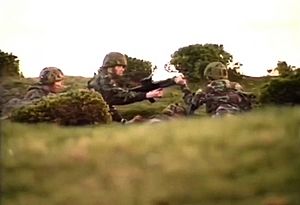Operation Conservation facts for kids
Quick facts for kids Operation Conservation |
|||||||
|---|---|---|---|---|---|---|---|
| Part of The Troubles and Operation Banner | |||||||
 A British Army position near Cullyhanna after the event, 7 May 1990 |
|||||||
|
|||||||
| Belligerents | |||||||
| Commanders and leaders | |||||||
| Unknown | Lance Sergeant Graham Stewart † |
||||||
| Strength | |||||||
| 1 ASU | 1 Infantry section | ||||||
| Casualties and losses | |||||||
| None | 1 killed | ||||||
Operation Conservation was a plan by the British Army to surprise a group of fighters from the Provisional Irish Republican Army (IRA). This event happened in south County Armagh, near the towns of Cullyhanna and Silverbridge. The operation took place on May 6, 1990. However, the IRA's South Armagh Brigade found out about the plan and stopped it.
The British Army's Plan
The British Army wanted to trick a large IRA group into attacking their soldiers. These soldiers were from a unit called the Light Infantry. They set up their troops around the road between Cullyhanna and Silverbridge. A few days before, on April 28, another Light Infantry patrol was shot at in the same area. More than 180 bullets were fired, and one soldier was hurt in the leg.
For Operation Conservation, the main British position was to be hidden and watched. Sixteen hidden groups of soldiers, called sections, from the 2nd Battalion Scots Guards were watching. Their goal was to surprise and stop any IRA group trying to enter the area.
What Happened During the Action
The British soldiers moved into the area very early on May 3. But the IRA's South Armagh Brigade was watching these movements. They managed to spot several of the hidden observation posts (OPs). An OP is a secret place where soldiers watch an area.
The IRA decided to attack one British position at Slatequarry, near Cullyhanna. This spot was the most open and easy to reach. A writer named David McKittrick said that the British soldiers were drawn to an open field. They saw smoke coming from a chimney of an old, empty building.
Just after midnight on May 5, the exposed British position came under heavy machine-gun fire. An IRA group was hidden on a nearby hill, about 400 yards away. The IRA members had built firing spots with stones around an old house. They hid these spots with green military covers.
The British OP was shot at by two 7.62 mm General purpose machine guns (GPMGs) and a Heckler & Koch G3 rifle. The rifle was used to cover the machine-gun teams as they moved away. They went towards Slatequarry road, where a vehicle was waiting for them. The IRA also placed a bomb between the British position and the road. This was to stop the British from chasing them.
The shooting lasted about 90 seconds. A total of 316 bullets were fired by both sides. The IRA fired 188 rounds, and the Scots Guards fired 128. The leader of the British patrol, Lance Sergeant Graham Stewart, was hit. He sadly died from his injuries the next day.
Aftermath of the Event
The IRA's surprise attack stopped the British operation. The British officer in charge then called off the mission. He later said that the IRA's attack was one of their best in South Armagh. He noted that they found the weakest spot in the British plan. This showed how skilled the IRA was in planning and in the field.
After this event, another senior British officer realized that a very skilled machine-gun team was working near Cullyhanna. On September 20, another soldier was badly wounded in that area. This happened during an attack on a 1st Cheshire Regiment patrol. On September 26, a helicopter was hit as it landed at Newtownhamilton. A soldier was wounded in the stomach. The British army called the IRA unit responsible for these attacks the "Cullyhanna Gun Club."
Writer Toby Harnden suggested that the IRA's actions showed they could challenge the British troops. This was especially true in South Armagh. The IRA knew the local area much better and were good at hiding.
Lance Sergeant Stewart was 24 years old when he died. He was buried with full military honors in his hometown of Perth, Scotland on May 11, 1990.
See also
- Chronology of Provisional Irish Republican Army actions (1990-1999)
- South Armagh Sniper (1990–1997)
- Attack on Cloghogue checkpoint
- Battle of Newry Road
- Glasdrumman ambush


